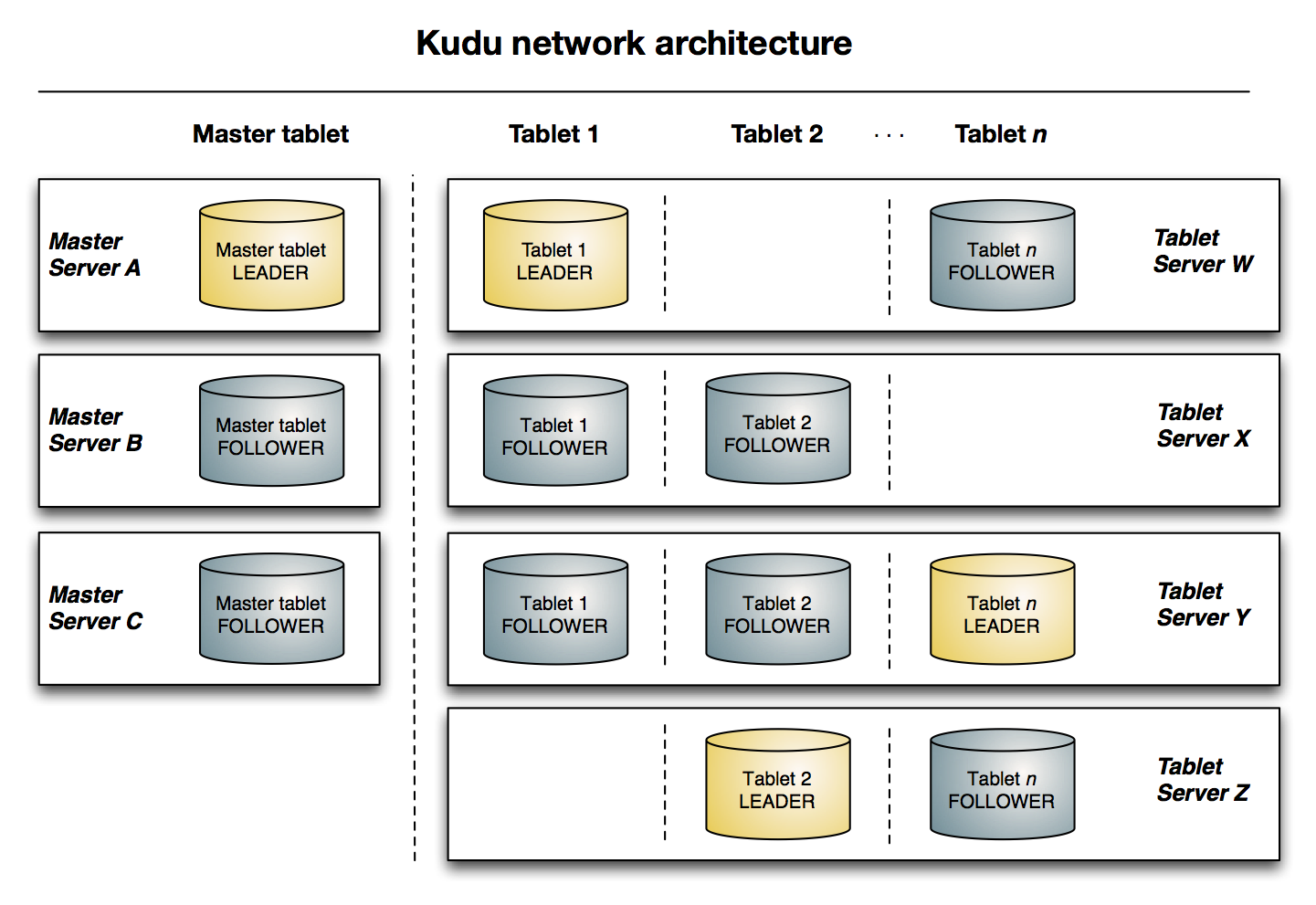Apache Kudu Concepts and Architecture
Columnar Datastore
- Read Efficiency
- For analytical queries, you can read a single column, or a portion of that column, while ignoring other columns. This means you can fulfill your request while reading a minimal number of blocks on disk. With a row-based store, you need to read the entire row, even if you only return values from a few columns.
- Data Compression
- Because a given column contains only one type of data, pattern-based compression can be orders of magnitude more efficient than compressing mixed data types, which are used in row-based solutions. Combined with the efficiencies of reading data from columns, compression allows you to fulfill your query while reading even fewer blocks from disk.
Raft Consensus Algorithm
The Raft consensus algorithm provides a way to elect a leader for a distributed cluster from a pool of potential leaders. If a follower cannot reach the current leader, it transitions itself to become a candidate. Given a quorum of voters, one candidate is elected to be the new leader, and the others transition back to being followers. A full discussion of Raft is out of scope for this documentation, but it is a robust algorithm.
Kudu uses the Raft Consensus Algorithm for the election of masters and leader tablets, as well as determining the success or failure of a given write operation.
Table
A table is where your data is stored in Kudu. A table has a schema and a totally ordered primary key. A table is split into segments called tablets, by primary key.
Tablet
A tablet is a contiguous segment of a table, similar to a partition in other data storage engines or relational databases. A given tablet is replicated on multiple tablet servers, and at any given point in time, one of these replicas is considered the leader tablet. Any replica can service reads. Writes require consensus among the set of tablet servers serving the tablet.
Tablet Server
A tablet server stores and serves tablets to clients. For a given tablet, one tablet server acts as a leader and the others serve follower replicas of that tablet. Only leaders service write requests, while leaders or followers each service read requests. Leaders are elected using Raft consensus. One tablet server can serve multiple tablets, and one tablet can be served by multiple tablet servers.
Master
The master keeps track of all the tablets, tablet servers, the catalog table, and other metadata related to the cluster. At a given point in time, there can only be one acting master (the leader). If the current leader disappears, a new master is elected using Raft consensus.
The master also coordinates metadata operations for clients. For example, when creating a new table, the client internally sends the request to the master. The master writes the metadata for the new table into the catalog table, and coordinates the process of creating tablets on the tablet servers.
All the master's data is stored in a tablet, which can be replicated to all the other candidate masters.
Tablet servers heartbeat to the master at a set interval (the default is once per second).
Catalog Table
The catalog table is the central location for metadata of Kudu. It stores information about tables and tablets. The catalog table is accessible to clients through the master, using the client API. The catalog table cannot be read or written directly. Instead, it is accessible only through metadata operations exposed in the client API. The catalog table stores two categories of metadata:
| Contents of the Catalog Table | |
|---|---|
| Tables | Table schemas, locations, and states |
| Tablets | The list of existing tablets, which tablet servers have replicas of each tablet, the tablet's current state, and start and end keys. |
Logical Replication
Kudu replicates operations, not on-disk data. This is referred to as logical replication, as opposed to physical replication. This has several advantages:
- Although inserts and updates transmit data over the network, deletes do not need to move any data. The delete operation is sent to each tablet server, which performs the delete locally.
- Physical operations, such as compaction, do not need to transmit the data over the network in Kudu. This is different from storage systems that use HDFS, where the blocks need to be transmitted over the network to fulfill the required number of replicas.
- Tablets do not need to perform compactions at the same time or on the same schedule. They do not even need to remain in sync on the physical storage layer. This decreases the chances of all tablet servers experiencing high latency at the same time, due to compactions or heavy write loads.
Architectural Overview
The following diagram shows a Kudu cluster with three masters and multiple tablet servers, each serving multiple tablets. It illustrates how Raft consensus is used to allow for both leaders and followers for both the masters and tablet servers. In addition, a tablet server can be a leader for some tablets and a follower for others. Leaders are shown in gold, while followers are shown in grey.
